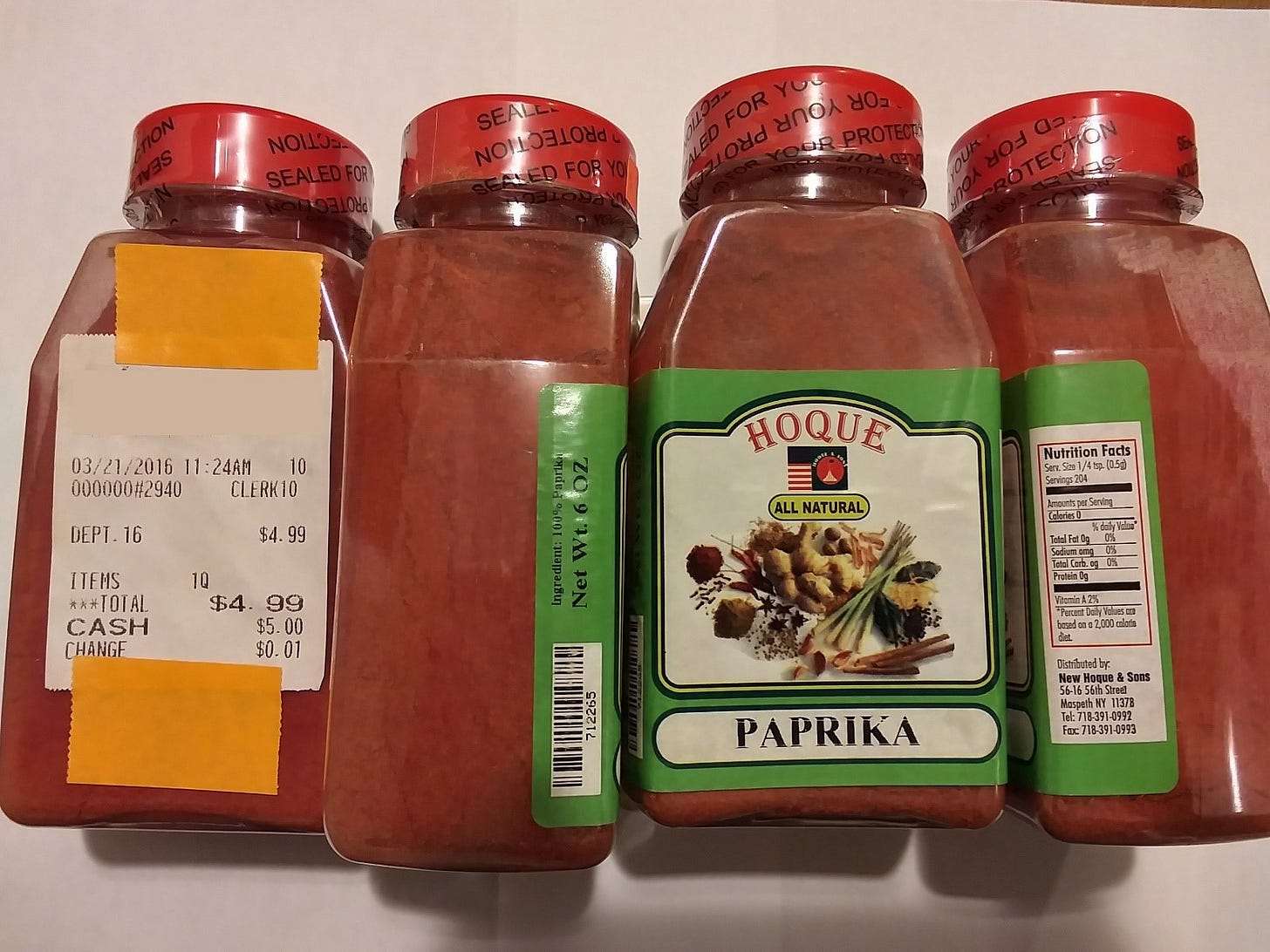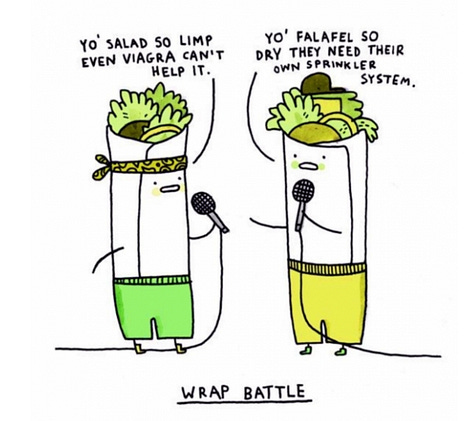137 | Case Study: Paprika Adulteration | New Info for Plastic Safety | Punny Eggs |
Plus, BPA is in clothes too?!!
Save the date: Meet-up on Thursday 16th May;
Case study: Paprika adulterated with carcinogenic dye;
Food Safety News and Resources;
Plastic safety news: nanoplastics in bottled water, disease costs from plastic and BPA in spandex clothes;
Egg and sandwich puns (Just for fun);
Food fraud news, emerging issues and recent incidents
It’s been a wonderful week, thank you so much! Today’s big thank you is for 👏👏 Mariane from the UK 👏👏 whose special ‘Good Apple’ subscription provided a scholarship to Andrea from The University of Natural Resources and Life
Sciences, Vienna. Andrea is a PhD candidate working on DNA metabarcoding of plant DNA. A huge thank you to Mariane. Mariane says she wants to ensure knowledge is shared with students for food safety now and in the future.
I couldn’t support students like Andrea without your financial support, thank you!
Welcome to Issue 137 of The Rotten Apple.
This week’s issue features the story of Thomas, a New York food chemist who went looking for food fraud in spices and found shocking levels of carcinogenic industrial dyes. Plus, new information on plastics safety and silly food puns.
Our May meetup is on Thursday the 16th. I hope to see you there.
Have a wonderful week,
Karen
P.S. If you love this newsletter, please tell your friends and colleagues about it and help grow our community of global food safety champions.
Case Study: Fraudulent Paprika
Can paprika and chilli powder be “too red”?
This post was updated on 13th May 2024
In 2016 an inspector from the New York State (NYS), Department of Agriculture and Markets visited a food market looking for suspicious spices. There had been a spate of adulteration incidents with paprika and related spices such as chilli powder and curry powder internationally and the New York authorities were surveying local supplies.
The inspector was Audrey, a colleague of Tom Tarantelli, now retired. Tom recently sent me an intriguing photograph of some products from the same brand that Audrey spotted that day.
In one store, Audrey noticed some packages of paprika that looked “too red”. This was, perhaps, a sign the paprika had been adulterated with unauthorised colourants.
She purchased the paprika and took it back to the lab for testing. It was, indeed adulterated. Tom told me they found 2,400 ppm Sudan 4 and 850 ppm Sudan 1 in the product. It was one of the highest concentrations of Sudan 4 ever found, as high as the worst European case that had been reported up to that time.
The results were so remarkable that Tom purchased more packages to keep. “Realizing this product would be thrown away, I went to the store and obtained more. Such a great sample!” Tom told me.
That was in 2016, eight years ago. Today, the products Tarantelli purchased are still a brightly-hued, fresh-looking red.

The photograph above was taken just a few months ago, more than seven years after the samples were purchased. The colour is bright. Pure paprika, on the other hand, loses its red colour over time and ages to a dull brownish colour.
This is the challenge for spice traders: old paprika doesn’t have an attractive colour. Dull-coloured paprika is perceived to be of lower quality and to have less flavour, and therefore must be sold for a lower price.
One solution is for traders to add colouring agents to their wares. Since pure spices are not allowed to contain even food-grade colourants, the traders do not bother to use colourants that are safe or legal. Instead, they use colourants that are cheap, easy to obtain and easy to handle.
Sudan dyes seem to be popular with unethical spice traders who want to enhance the colour of the spices they sell. The dyes are industrial colouring agents, much cheaper than food-grade colours, and sold for use in industrial oils, waxes and shoe polish. Sudan I has an orange colour and Sudan IV is a blueish red. Sudan dyes have been found in paprika, chilli powder and curry powder many times over the past decade. They are also a common adulterant in unrefined palm oil, which has a bright red colour when fresh.
Sudan dye adulteration was first detected in food in 2003, and was the cause of a huge recall in the United Kingdom in 2005, which affected 570 foods. Alerts and notifications for Sudan dye contamination continue to this day. Last month Italian authorities rejected palm oil from Ivory Coast because it contained Sudan 3 and Sudan 4 dyes and German authorities recalled cheddar cheese powder from Syria which contained multiple Sudan dyes.
There were 39 notifications for Sudan dyes in foods between 2014 and 2024 in the European Rapid Alert System for Food and Feed (RASFF), and 12 in the US FDA Import Alerts records. Many of the alerts are for adulterated palm oil, but in Europe, paprika, seasoning and spice blends, barbeque rub, chilli pepper, sumac and sweet and sour sauce were also affected. In America, barbeque flavoured snacks were affected in addition to palm oil.

The incident in 2016 wasn’t the only time Tarantelli and his colleagues found Sudan dyes in spices. In fact, they found sixteen commercially available spices containing such dyes in less than two years. The spices included turmeric, curry powder, malathy and chilli powder in addition to paprika.

The New York State inspectors reported their results to the US FDA, prompting a series of recalls. Unfortunately, the recalls were classed as less serious Class 2 recalls because of the assumption that spices like paprika are consumed in only small quantities.
However, as Tarantelli pointed out in an article he wrote in Food Safety Tech in 2017, assumptions about serving sizes can be wrong. In fact, when he compared the amount of spice consumed by some ethnic groups to the reference serving size used by the FDA they were 20 times higher.
“In the Code of Federal Regulations (CFR) Title 21, the serving size per meal for spice is referenced as ½ gram. However, certain ethnic groups may consume a daily amount of 20 grams of spice per person.”
Takeaways for food safety professionals
Foods that appear fresher, tastier or of better quality when their colour is more intense are vulnerable to adulteration with undeclared colourants.
Red-coloured foods such as paprika, chilli powder and palm kernel oil are sometimes adulterated with Sudan dyes to enhance their colour and increase their apparent value.
Sudan dyes are not approved for use in food, they are industrial dyes with carcinogenic properties.
Despite a long history of recalls, safety alerts and import alerts for Sudan dye adulteration, food fraud perpetrators continue to adulterate foods with this dangerous group of chemicals.
Although some food regulators consider adulterated spices to present a lower risk to consumers than other foods, because many people consume them in small amounts, some sectors of the population consume significant quantities of spices and are therefore at higher risk.
Food businesses that purchase red-coloured foods including spices and unrefined palm oil should consider such foods vulnerable to Sudan dye adulteration, and implement mitigations.
Main sources:
Castell, A., Arroyo-Manzanares, N., López-García, I., Zapata, F. and Viñas, P. (2024). Authentication strategy for paprika analysis according to geographical origin and study of adulteration using near infrared spectroscopy and chemometric approaches. Food control, 161, pp.110397–110397. doi:https://doi.org/10.1016/j.foodcont.2024.110397.
Tarantelli, T (2024), correspondence with author.
Tarantelli, T. (2017). Adulteration with Sudan Dye Has Triggered Several Spice Recalls. [online] FoodSafetyTech. Available at: https://foodsafetytech.com/feature_article/adulteration-sudan-dye-triggered-several-spice-recalls/.
There are ‘protected origin’ paprikas in Europe (more correctly known as Protected Designation of Origin (PDO)). These protected paprikas are from specific regions and are known for their unique regional characteristics. For example, there is a special paprika from a certain part of Spain called Pimentón de La Vera and one from Hungary called Kalocsai fűszerpaprika-őrlemény. Source: Castell et al (2024)
Food Safety News and Resources
My weekly food safety news roundups are free for everyone and never boring.
This week’s most interesting story is about parasitic worms (human pathogens) found in canned sardines. Plus, the number of US dairy herds affected by bird flu could be higher than we thought, with viral fragments found in around one-quarter of commercial milk samples. And three free webinars, for your edification. Click the preview below to read.
Food Safety News and Resources | May
6 May | Food Safety News and Free Resources | Bird flu fragments in dairy products (USA) | Recall trends (USA, Europe) | Artificial smoke flavour declared unsafe and banned (Europe) | Ethylene oxide in spices from India | Parasitic worms in canned fish (Malaysia) |
Plastics and Food Safety, 3 Quick Bites
Disease costs from additives in plastic packaging
The cost of diseases caused by plastic additives including phthalates, PFAS chemicals and bisphenols has been estimated by researchers in a study published in February.
The disease burden of phthalates was estimated at $67 billion in the USA in 2018, with PFAS chemicals and bisphenols costing $22 billion and $1 billion respectively.
Source:
Trasande, L., Roopa Krithivasan, Park, K., Vladislav Obsekov and Belliveau, M. (2024). Chemicals Used in Plastic Materials: An Estimate of the Attributable Disease Burden and Costs in the United States. Journal of the Endocrine Society, 8(2). doi:https://doi.org/10.1210/jendso/bvad163.
New information: nano plastics measurements (and their presence in bottled water)
We’ve previously heard how microplastics and nanoplastics are time-consuming and expensive to measure in foods. Researchers have developed a rapid method to ‘count’ the number of micro and nano plastic particles in samples. The method makes use of hyperspectral stimulated Raman scattering (SRS) microscopy combined with an automated plastic identification algorithm. They used the method to count the number of particles in bottled water and found more than 105 particles (that’s 100,000) in each litre of bottled water. About 90% of the particles were nanoplastics.
Source:
Qian, N., Gao, X., Lang, X., Deng, H., Bratu, T.M., Chen, Q., Stapleton, P., Yan, B. and Min, W. (2024). Rapid single-particle chemical imaging of nanoplastics by SRS microscopy. Proceedings of the National Academy of Sciences of the United States of America, [online] 121(3), p.e2300582121. doi:https://doi.org/10.1073/pnas.2300582121.
BPA: alarm bells over its use in clothing
This story is not strictly food-related, but I’ve included it to demonstrate how awareness of the potential dangers of various plastics-additive chemicals is growing. A US-based nonprofit consumer advocacy group has tested sports clothing and found some brands to contain high levels of bisphenol A (BPA). They allege that long-term wearing of such clothes could expose users to more than twenty times the safety limits set in California.
In the food industry, BPA is most often used in polycarbonate beverage containers and in the linings of some food cans/tins. It is ingested when it migrates into the food or water inside the BPA-containing package.
As well as being ingested, BPA can also be absorbed through the skin. Thermal-printed paper receipts/dockets are a source of exposure for BPA, which is absorbed when thermal print papers are touched with bare hands.
In clothing, BPA is added to fibres to make them soft and malleable. In tests conducted by the consumer group (published in 2023), it was found only in polyester-based clothing containing spandex, including sports bras, sports shorts, leggings and athletic shirts from premium brands.
Source:
Carnevale, S. (2023). What You Need to Know About BPA in Clothing. [online] Center for Environmental Health. Available at: https://ceh.org/what-you-need-to-know-about-bpa-in-clothing/.
Egg and Sandwich Puns (just for fun)
Clever folks on Instagram have reimagined a rap battle as a wrap battle and scrabbled up some eggs.



Thanks to Food Bytes for sharing these.
Below for paying subscribers: Food fraud news, horizon scanning and incident reports
📌 Food Fraud News 📌
📌 Food Fraud News 📌
In this week’s food fraud news:
📌 Food fraud trends in 2023;
📌 Premium wines at risk;
📌 Large-scale grain fraud; illegal meat imports;
📌 Palm sugar fraud.






